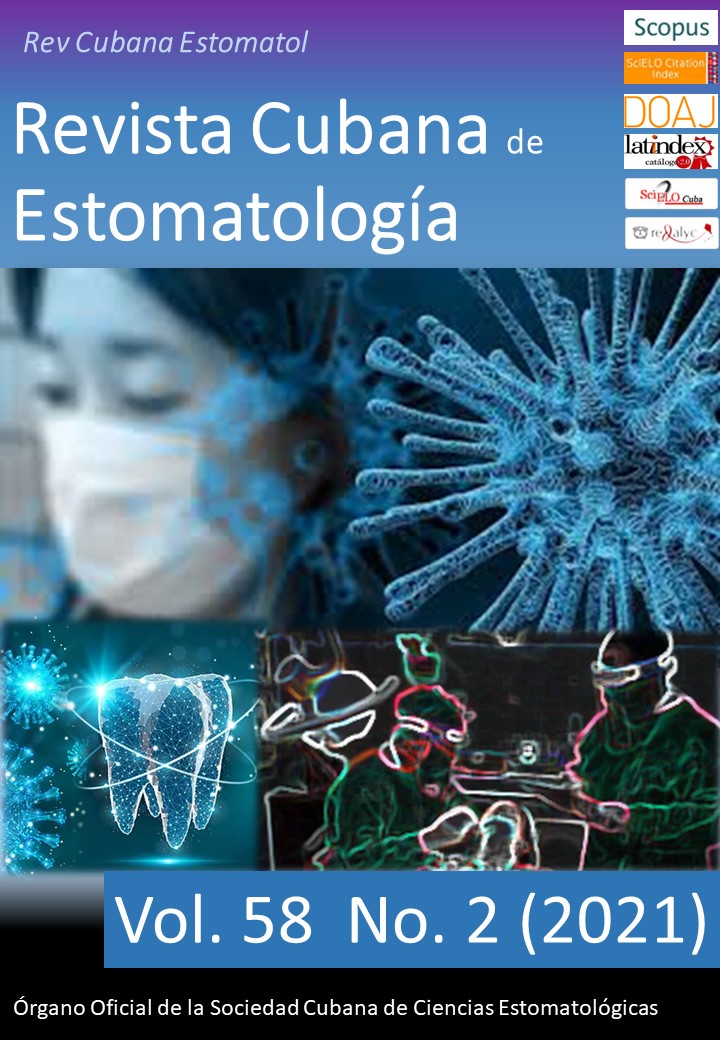Marginal microleakage of bulk fill and nanohybrid resins in deciduous teeth
Keywords:
dental leakage, composite resins, primary tooth, dental materials.Abstract
Introduction: In children's dental care it is crucial to select restorative materials of proven clinical quality and a short application period, particularly with patients of limited attention capacity. Due to their improved physical and mechanical properties, composite resins are currently one of the materials of choice for children's dental care. Bulk fill resins are an attractive alternative for posterior restorations. Objective: Compare the degree of marginal microleakage of bulk fill and nanohybrid resins in deciduous teeth. Methods: An experimental in vitro study was conducted of 40 deciduous teeth extracted for therapeutic reasons, which were divided into two groups. Group I: nanohybrid resin by incremental technique (Tetric® N Ceram – Ivoclar Vivadent) and Group II: bulk fill resin by monoincremental technique (Tetric® N Ceram bulk fill - Ivoclar Vivadent). A manual 500-cycle thermocycling procedure was performed at 5ºC ± 2ºC to 55ºC ± 2ºC. The samples were soaked in 0.5% methylene blue at 37ºC for 24 hours and analyzed under a light stereo microscope at 40X. Results: Microleakage was present in all the samples. In the nanohybrid resin group, microleakage was mild in 25%, moderate in 30% and severe in 45%. In the bulk fill resin group, microleakage was mild in 30%, moderate in 35% and severe in 35%. No significant difference was found between the groups (p = 0.55). Conclusions: Both resins, bulk fill and nanohybrid, presented similar in vitro marginal microleakage in deciduous molars. The bulk fill technique is therefore a good alternative for children's dental rehabilitation, due to its easy and fast application in a single session.Downloads
References
Lenzi TL, Gimenez T, Tedesco TK, Mendes FM, Rocha RO, Raggio DP. Adhesive systems for restoring primary teeth: A systematic review and meta-analysis of in vitro studies. Int J Paediatr Dent. 2016 [acceso: 18/12/2019];26(5). Disponible en: https://onlinelibrary.wiley.com/doi/abs/10.1111/ipd.12210
Sabel N, Robertson A, Nietzsche S, Norén JG. Demineralization of Enamel in primary second molars related to properties of the Enamel. Sci. World J. 2012 [acceso: 20/12/2019]; 2012. Disponible en: https://www.hindawi.com/journals/tswj/2012/587254/
Gentile E, Di Stasio D, Santoro R, Contaldo M, Salerno C, Serpico R et al. In Vivo Microstructural Analysis of Enamel in Permanent and Deciduous Teeth. Ultrastruct Pathol. 2015 [acceso: 20/12/2019]; 39(2). Disponible en: https://www.tandfonline.com/doi/abs/10.3109/01913123.2014.960544?needAccess=true&journalCode=iusp20
Kidd E. Microleakage: a review. J Dent. 1976 [acceso: 18/12/2019]; 4(5). Disponible en: https://www.sciencedirect.com/science/article/abs/pii/0300571276900488?via%3Dihub
Ahmadi R, Ramazani N, Daryaeian M, Nabavi S. In vitro Comparison of Microleakage of Nanofilled and Flowable Composites in Restoring Class V Cavities in Primary Molars. J Res Med Sci. 2013 [acceso: 20/12/2019]; 15(1). Disponible en: https://pdfs.semanticscholar.org/b10d/5673826315108aae1aeff78e0c71e1764f75.pdf
Akah MM, Daifalla LE, Yousry MM. Bonding of bulk fill versus contemporary resin composites: A systematic review and meta-analysis. Indian J Sci Technol. 2016 [acceso: 20/12/2019]; 9(20). Disponible en: http://www.indjst.org/index.php/indjst/article/view/90525
Chesterman J, Jowett A, Gallacher A, Nixon P. Bulk-fill resin-based composite restorative materials: a review. Br Dent J. 2017 [acceso: 20/12/2019]; 222(5). Disponible en: https://www.nature.com/articles/sj.bdj.2017.214
Hirata R Kabbach W, De Andrade O, Bonfante E, Giannini M, Coelho P. Bulk fill composites: an anatomic sculpting technique. J. Esthet. Dent. 2015 [acceso: 16/12/2019]; 27(6). Disponible en: https://onlinelibrary.wiley.com/doi/full/10.1111/jerd.12159
Corral C, Vildósola P, Bersezio C, Alves Dos Campos E, Fernández E. Revisión del estado actual de resinas compuestas Bulk-Fill. Rev Fac Odontol Univ Antioq. 2015 [acceso: 17/12/2019]; 27(1). Disponible en: https://revistas.udea.edu.co/index.php/odont/article/view/19805
Gamarra VSS, Borges GA, Junior LHB, Spohr AM. Marginal adaptation and microleakage of a bulk-fill composite resin photopolymerized with different techniques. Odontology. 2018;106(1). PMID: 28160094
Gaintantzopoulou M, Gopinath V, Zinelis S. Evaluation of cavity wall adaptation of bulk esthetic materials to restore class II cavities in primary molars. Clin Oral Invest. 2017;21(4). PMID: 27165307
Mosharrafian S, Heidari A, Rahbar P. Microleakage of Two bulk fill and One Conventional Composite in Class II Restorations of Primary Posterior Teeth. J Dent (Tehran). 2017;14(3). PMCID: PMC5694844
Eltoum N, Bakry N, Talaat D, Elshabrawy S. Microleakage evaluation of bulk fill composite in class II restorations of primary molars. ADJ. 2019;44. PMCID: PMC5694844
Öter B, Deniz K, Çehreli SB. Preliminary data on clinical performance of bulk-fill restorations in primary molars. Niger J Clin Pract. 2018;21. PMID: 30417848
Ehlers V, Gran K, Callaway A, Azrak B, Ernst CP. One-year Clinical Performance of Flowable Bulk-fill Composite vs Conventional Compomer Restorations in Primary Molars. J Adhes Dent. 2019;21(3). Disponible en: 31093618
Downloads
Published
How to Cite
Issue
Section
License
Authors retain all rights to their works, which they can reproduce and distribute as long as they cite the primary source of publication.
The Rev Cubana Estomatol is subject to the Creative Commons Attribution-Non-Commercial 4.0 International License (CC BY-NC 4.0) and follows the publication model of SciELO Publishing Schema (SciELO PS) for publication in XML format.
You are free to:
- Share — copy and redistribute the material in any medium or format.
- Adapt — remix, transform, and build upon the material.
The licensor cannot revoke these freedoms as long as you follow the license terms.
Under the following terms:
Attribution — You must give appropriate credit, provide a link to the license, and indicate if changes were made. You may do so in any reasonable manner, but not in any way that suggests the licensor endorses you or your use.
- NonCommercial — You may not use the material for commercial purposes.
No additional restrictions — You may not apply legal terms or technological measures that legally restrict others from doing anything the license permits.
Notices:
- You do not have to comply with the license for elements of the material in the public domain or where your use is permitted by an applicable exception or limitation.
- No warranties are given. The license may not give you all of the permissions necessary for your intended use. For example, other rights such as publicity, privacy, or moral rights may limit how you use the material.


